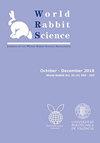儿童食用兔肉
IF 1.3
4区 农林科学
Q3 AGRICULTURE, DAIRY & ANIMAL SCIENCE
引用次数: 15
摘要
世界卫生组织推荐,兔肉的营养和饮食特性使其成为儿童的理想食物。然而,家中有18岁以下的儿童会减少食用兔肉的频率。如果我们关注有18岁以下儿童的家庭,52.5%的未成年人不吃兔肉。儿童(指18岁以下的人)不吃兔肉的主要原因是他们不喜欢兔肉(40.9%)和因为没有在家里买/吃兔肉(30.9%)。面对这种情况,迫切需要寻求适当的策略,使兔肉适应最年轻的家庭成员的消费。根据研究结果,提出了以下策略。首先,开发婴幼儿功能性食品,如富含ω3和二十二碳六烯酸的兔肉。第二,提高肉的嫩度。第三,为孩子们调整兔肉的展示方式(汉堡、鸡块、香肠、腌料……),把它们变成父母们的方便产品,延长它们的保质期。第四,适应儿童标签/包装,以吸引父母和后代的注意。最后,制定针对儿童和家长的兔肉营养价值宣传策略。据观察,如果未成年人吃兔肉,他们也会更频繁地吃其他类型的肉,如羊肉和牛肉。因此,在这类家庭中,就肉类消费而言,消费的是多样化和完整的饮食,因此有必要重新考虑三个肉类部门之间的联合沟通策略。在18岁以下的人群中推广兔肉消费有几个后果,因为未来他们将负责家庭采购或分担这一责任。本文章由计算机程序翻译,如有差异,请以英文原文为准。
Children's consumption of rabbit meat
The nutritional and dietary properties of rabbit meat make it an ideal food for children, recommended by the World Health Organisation. However, the presence of children under 18 in the home has been found to decrease the frequency of rabbit meat consumption. If we focus on households with children under 18, 52.5% of minors do not consume rabbit meat. The main reason why children (intended as people under 18 yr old) do not consume rabbit meat is the fact that they do not like it (40.9%) and because it is not bought/eaten at home (30.9%). Faced with this situation, there is a pressing need to seek appropriate strategies to adapt rabbit meat for consumption by the youngest family members. In light of the results, the following strategies are proposed. First, the development of functional foods for babies and children, such as rabbit meat enriched with ω3 and docosahexaenoic acid. Secondly, improving meat tenderness. Third, adapting rabbit meat presentations for children (burgers, nuggets, sausages, marinades …), converting them into convenience products for parents and extending their shelf life. Fourth, adapting the labelling/packaging for children to attract attention of both parents and offspring. Finally, developing communication strategies on the nutritional value of rabbit meat aimed at both children and parents. It is observed that if minors consume rabbit meat, they also eat other types of meat such as lamb and beef more often. Therefore, in this type of households a varied and complete diet is consumed in terms of meat consumption, so it would be necessary to rethink joint communication strategies among the three meat sectors. Promoting rabbit meat consumption among the under 18s has several consequences, as in the future they will be in charge of household purchases or share this responsibility.
求助全文
通过发布文献求助,成功后即可免费获取论文全文。
去求助
来源期刊

World Rabbit Science
农林科学-奶制品与动物科学
CiteScore
1.70
自引率
25.00%
发文量
22
审稿时长
>36 weeks
期刊介绍:
World Rabbit Science is the official journal of the World Rabbit Science Association (WRSA). One of the main objectives of the WRSA is to encourage communication and collaboration among individuals and organisations associated with rabbit production and rabbit science in general. Subject areas include breeding, genetics, production, management, environment, health, nutrition, physiology, reproduction, behaviour, welfare, immunology, molecular biology, metabolism, processing and products.
World Rabbit Science is the only international peer-reviewed journal included in the ISI Thomson list dedicated to publish original research in the field of rabbit science. Papers or reviews of the literature submitted to World Rabbit Science must not have been published previously in an international refereed scientific journal. Previous presentations at a scientific meeting, field day reports or similar documents can be published in World Rabbit Science, but they will be also subjected to the peer-review process.
World Rabbit Science will publish papers of international relevance including original research articles, descriptions of novel techniques, contemporaryreviews and meta-analyses. Short communications will only accepted in special cases where, in the Editor''s judgement, the contents are exceptionally exciting, novel or timely. Proceedings of rabbit scientific meetings and conference reports will be considered for special issues.
World Rabbit Science is published in English four times a year in a single volume. Authors may publish in World Rabbit Science regardless of the membership in the World Rabbit Science Association, even if joining the WRSA is encouraged. Views expressed in papers published in World Rabbit Science represent the opinion of the author(s) and do not necessarily reflect the official policy of the WRSA or the Editor-in-Chief.
 求助内容:
求助内容: 应助结果提醒方式:
应助结果提醒方式:


